POSTLUDE: Fundamentals of Music (Review – From “Open Music Theory”)
36 Inversion and Figured Bass
Chelsey Hamm and Samuel Brady
Key Takeaways
- The bass voice of triadic harmonies, often simply called the “bass,” determines inversion.
- Inverted harmonies do not have the root in the bass. When the third appears in the bass, we say the chord is in first inversion, when the fifth appears in the bass we say the chord is in second inversion, and when the seventh appears in the bass we say the chord is in third inversion.
- In addition to chord symbols, musicians also use figured bass to indicate inversion. Each triad and seventh chord is indicated by unique figures, which are often abbreviated.
- Figured bass is not usually added to chord symbols; however, it is added to triadic shorthand notation.
- It is called realizing figured bass when musicians turn figured bass into chords, either on paper or in performance.
- Triads and seventh chords are identified according to their root, quality, and inversion. Inversion includes the appropriate figures if applicable.
- In order to denote chromatic alterations to notes, musicians put accidentals (♭, ♯, ♮) before the figure that is altered. Musicians also use slashes through a figure or a plus sign before a figure, in order to indicate raising the note by a half step.
Triadic Inversion and Figures
Musicians often prioritize the note that is in the bass voice of triadic harmonies, often simply called the “bass,” which is the lowest part (or voice) of a composition, regardless of what instrument or voice type is singing or playing that lowest note. Example 1 shows an A major triad with three different notes in the bass and chord symbols (above the staff):
https://musescore.com/user/32728834/scores/6839459/embed
Example 1. An A major triad in root position, first inversion, and second inversion.
An A major triad consists of three notes, the root (A), the third (C♯), and the fifth (E). When a triad is stacked in thirds (i.e. “snowperson form”), we say the triad is in root position. The bass note in root position is the root. Chords that do not have the root in the bass are said to be inverted, as summarized in Example 2:
[table “69” not found /]
Example 2. A summary of triadic inversions, root, and bass.
As seen in Example 2, when the third appears in the bass, we say the triad is in first inversion, and when the fifth appears in the bass we say the triad is in second inversion.
It is important to note that the bass voice of the chord is NOT the same thing as the chord’s root. The root of an A major triad is always A, regardless of whether the triad is in root position, first inversion, or second inversion. However, the bass voice changes between these inversions, from A to C♯ to E, as seen in Example 1 and Example 2.
You might think of first inversion triads as looking like a snowperson whose feet have been moved above their head, while a second inversion triad looks like a snow person whose head has been moved to where their feet would normally appear. Example 3 demonstrates this similarity:
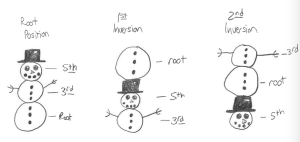
Sometimes musicians use chord symbols to indicate inversions, as seen in Example 1. However, musicians also use figured bass to indicate inversion. Figured bass uses Arabic numerals and some symbols which indicate intervals above the bass (NOT the root) note. These are then interpreted as chords by musicians.
Example 4 shows the full figured bass for triads underneath their chord symbols:
https://musescore.com/user/32728834/scores/6839460/embed
Example 4. The full figured bass for triadic inversions.
As you can see in Example 4, a root position triad has a third and a fifth above the bass. A first inversion triad has a third and a sixth above the bass, while a second inversion triad has a fourth and a sixth above the bass. In figured bass, the larger numerals (intervals) always appear above the smaller ones.
Many centuries ago, however, musicians abbreviated the full figured bass for triads and seventh chords in order to save time and supplies (paper and ink were very expensive before the industrial revolution). Example 5 shows the abbreviated figured bass for triads that we usually use today underneath their chord symbols:
https://musescore.com/user/32728834/scores/6839461/embed
Example 5. The abbreviated figured bass for triadic inversions.
As you can see, no figure appears for root position. First inversion triads are abbreviated with the superscript number “6,” while a second inversion triad keeps its full figures, “![]() ,” to distinguish it from a first inversion triad.
,” to distinguish it from a first inversion triad.
Figured bass is not usually added to chord symbols; however, it is added to triadic shorthand notation. For example, the last measure of example 5 would be notated as “A/E” in chord symbols. Using triadic shorthand, this chord would be notated as “A![]() .”
.”
When musicians turn figured bass into chords—either on paper or in performance—this is called realizing the figured bass. Example 6 shows the process of realization for several triads:
https://musescore.com/user/32728834/scores/6839462/embed
Example 6. Some triads with figured bass and their realizations.
As seen in the first measure of Example 6, an E♭ appears with no figured bass next to it. Therefore, we can assume that we are realizing an E♭ major triad in root position. This chord is realized (written out with notes) in the next measure. In measure 3, we see the number “6” below the bass note G. We can understand that notation to mean that we are realizing an E♭ major triad in first inversion. This chord is realized in the next measure. In measure 5, we see the figures “![]() ” below the bass note B♭. This notation means that we are realizing an E♭ major triad in second inversion, realized in the next measure.
” below the bass note B♭. This notation means that we are realizing an E♭ major triad in second inversion, realized in the next measure.
Example 7 shows the process of realization for a triad in first inversion in more detail:
https://musescore.com/user/32728834/scores/6839464/embed
Example 7. Realizing a Gm triad in first inversion in three steps.
As seen in Example 7, we first see the bass note B♭ with the figure “6” underneath. This means that the third of the triad is in the bass. We can now find the root of the chord, which is G. In the second measure of Example 7, a G minor triad in root position has been realized in parentheses. In the third measure of Example 7, the third of the chord (the B♭) is in the bass; now the triad is in first inversion. The last measure of Example 7 is the correct “answer” or realization of this chord symbol.
Example 8 shows the process of realization for a triad in second inversion in more detail:
https://musescore.com/user/32728834/scores/6839465/embed
Example 8. Realizing a B triad in second inversion in three steps.
As seen in Example 8, we are realizing a B ![]() triad—a B major triad in second inversion. In the first measure, we see an F# with the figured bass “
triad—a B major triad in second inversion. In the first measure, we see an F# with the figured bass “![]() “underneath. This means that the fifth of the triad is in the bass, and we must find the root of the chord, which is B. In the second measure of Example 8, a B major triad in root position has been realized in parentheses. In the third measure of Example 8, the fifth of the chord (the F♯) appears in the bass; this chord is now in second inversion. The last measure of Example 8 is the correct “answer” or realization of this figure.
“underneath. This means that the fifth of the triad is in the bass, and we must find the root of the chord, which is B. In the second measure of Example 8, a B major triad in root position has been realized in parentheses. In the third measure of Example 8, the fifth of the chord (the F♯) appears in the bass; this chord is now in second inversion. The last measure of Example 8 is the correct “answer” or realization of this figure.
Identifying Triads
Triads are identified according to their root, quality, and inversion. With the addition of inversion, you can identify triads in four steps:
- Identify and write its root.
- Identify and write its quality.
- Identify its inversion.
- Write the appropriate figured bass figures if applicable.
Example 9 shows a triad in inversion (measure 1) and root position (measure 2):
https://musescore.com/user/32728834/scores/6839468/embed
Example 9. A triad in inversion (measure 1) and root position (measure 2).
The four-step process of identification for the triad in measure 1 is as follows:
- In measure 2, the chord has been put into root position. Now we can see the root of the triad is D.
- This triad is minor.
- The third of the triad is in the bass; therefore this triad is in first inversion.
- Using figured bass, we would identify this triad as Dm6. Using chord symbols, we would identify this triad as Dm/F.
Example 10 shows another triad in inversion (measure 1) and root position (measure 2):
https://musescore.com/user/32728834/scores/6876514/embed
Example 10. A triad in inversion (measure 1) and root position (measure 2).
The four-step process of identification for the triad in measure 1 is as follows:
- In measure 2, the chord has been put into root position. Now we can see the root is A.
- This triad is major.
- The fifth of the triad in the bass; therefore this triad is in second inversion.
- Using figured bass, we would identify this triad is A
 . Using chord symbols, we would identify this triad as A/E.
. Using chord symbols, we would identify this triad as A/E.
Note that the second measure of example 9 and example 10 are in parentheses. It is recommended that you imagine the chord in root position rather than write it out in order to save time.
Seventh Chord Inversion and Figures
Like triads, seventh chords can also be inverted; in other words, their root doesn’t necessarily have to be the bass. Example 11 shows an A7 chord in root position, first inversion, second inversion, and third inversion:
https://musescore.com/user/32728834/scores/6843779/embed
Example 11. Seventh chord inversions.
As you can see in Example 11, when a seventh chord has its root in the bass it is in root position. When the third appears in the bass it is in first inversion, and when the fifth appears in the bass it is in second inversion. Seventh chords have one more note than triads, so they have one additional inversion. When the chordal seventh of a seventh chord is in the bass it is in third inversion. Don’t forget that the bass and the root of the chord are NOT synonymous. In Example 11 the root of the chord is always A, regardless of its inversion and bass note.
A summary of the different seventh chord inversions can be seen in Example 12:
[table “70” not found /]
Example 12. A summary of seventh chord inversion, root, and bass.
We also use figured bass to indicate the inversion of seventh chords. Example 13 shows the full figured bass for seventh chords underneath their chord symbols:
https://musescore.com/user/32728834/scores/6843780/embed
Example 13. Seventh chord inversions with chord and figured bass.
As you can see in Example 13, a root position seventh chord has a third, fifth, and chordal seventh above the bass. A first inversion seventh chord has a third, fifth, and a sixth above the bass, while a second inversion seventh chord has a third, a fourth, and a sixth above the bass. Finally, a third inversion seventh chord has a second, a fourth, and a sixth above the bass.
Example 14 shows the abbreviated figured bass for seventh chords that musicians use today underneath their chord symbols:
https://musescore.com/user/32728834/scores/6843782/s/mesgHK/embed
Example 14. The abbreviated figures for seventh chord inversion.
As seen in Example 14, a root position seventh chord is abbreviated with just the number “7,” while a first inversion seventh chord is abbreviated as “![]() .” A second inversion seventh chord is abbreviated “
.” A second inversion seventh chord is abbreviated “![]() ,” and a third inversion seventh chord is abbreviated as “
,” and a third inversion seventh chord is abbreviated as “![]() .” Sometimes, in older style figured bass notation, a third inversion seventh chord is notated as “2.”
.” Sometimes, in older style figured bass notation, a third inversion seventh chord is notated as “2.”
You can realize figured bass for inverted seventh chords in a similar way to how you realized them for triads. To realize an inverted seventh chord, first realize the chord in root position, then invert the chord. Example 15 shows this process for a Gmm![]() chord (chord symbol Gmi7/B♭).
chord (chord symbol Gmi7/B♭).
https://musescore.com/user/32728834/scores/6843784/embed
Example 15. Realizing an inverted seventh chord.
As seen in example 15, we first see the bass note B♭ with the figured bass “![]() ” underneath. This means that the third of the seventh chord is in the bass. We can now find the root of the chord, which is G. In the second measure of example 15, a Gmm7 (chord symbol Gmi7) seventh chord has been realized in parentheses. In the third measure of example 15, the third of the chord (B♭) is in the bass; now the triad is in first inversion.
” underneath. This means that the third of the seventh chord is in the bass. We can now find the root of the chord, which is G. In the second measure of example 15, a Gmm7 (chord symbol Gmi7) seventh chord has been realized in parentheses. In the third measure of example 15, the third of the chord (B♭) is in the bass; now the triad is in first inversion.
Example 16 shows another figured bass realization with inversion:
https://musescore.com/user/32728834/scores/6876603/embed
Example 16. Realizing an inverted seventh chord.
As seen in example 16, we first see the bass note F with the figured bass “![]() ” underneath. This means that the fifth of the seventh chord is in the bass. We can now find the root of the chord, which is B♭. In the second measure of example 16, a B♭MM7 (chord symbol B♭M7) seventh chord has been realized in parentheses. In the third measure of example 16, the fifth of the chord (F) is in the bass; now the triad is in second inversion.
” underneath. This means that the fifth of the seventh chord is in the bass. We can now find the root of the chord, which is B♭. In the second measure of example 16, a B♭MM7 (chord symbol B♭M7) seventh chord has been realized in parentheses. In the third measure of example 16, the fifth of the chord (F) is in the bass; now the triad is in second inversion.
Identifying Seventh Chords
Like triads, seventh chords are also identified according to their root, quality, and inversion. You can identify seventh chords in five steps:
- Identify and write its root.
- Identify and write its quality of triad.
- Identify and write its quality of seventh.
- Identify its inversion if applicable.
- Write the appropriate figured bass figures if applicable.
Example 17 shows a seventh chord in inversion and the process of identification:
https://musescore.com/user/32728834/scores/6843787/embed
Example 17. A seventh chord in inversion (measure 1) and root position (measure 2).
The five-step process of identification for the seventh chord in measure 1 is as follows:
- In measure 2, the seventh chord has been put into root position (measure 2). Now we can see the root of the chord is E.
- This triad is minor.
- The chordal seventh is also minor.
- The original example is in first inversion, because the third is in the bass.
- This chord is an Emm
 (chord symbol Emi7/G) chord.
(chord symbol Emi7/G) chord.
Another seventh chord in inversion is shown in Example 18, along with the process of identification:
https://musescore.com/user/32728834/scores/6876617/embed
Example 18. A seventh chord in inversion (measure 1) and root position (measure 2).
The five-step process of identification for the seventh chord in measure 1 is as follows:
- In measure 2, the seventh chord has been put into root position (measure 2). Now we can see the root of the chord is G.
- The triad is major.
- The chordal seventh is minor.
- The original example is in third inversion, because the seventh is in the bass.
- This chord is an GMm
 (chord symbol G7/F) chord.
(chord symbol G7/F) chord.
Note that the second measure of Example 17 and Example 18 are in parentheses. It is recommended that you imagine the chord in root position rather than write it out in order to save time.
Other Figured Bass Symbols
In order to denote chromatic alterations to notes, musicians put accidentals (♭, ♯, ♮) before the figure that is altered. Example 19 shows a few realizations of figures with accidentals:
https://musescore.com/user/32728834/scores/6877976/embed
Example 19. Realizations of figures with accidentals.
Musicians also use slashes through a figure or a plus sign before a figure, in order to indicate raising the note by a half step. These symbols and their realizations are shown in Example 20:
https://musescore.com/user/32728834/scores/6878013/embed
Example 20. Realization of figures with other symbols.
An orphaned accidental (or hanging accidental) is also common. These are accidentals, that appear by themselves, not accompanying any other figure or symbol. In these cases, the accidental is assumed to apply to the third above the bass, as seen in Example 21:
https://musescore.com/user/32728834/scores/6878023/embed
Example 21. Realization of orphaned accidentals.
Take note that if only a “7” appears below the bass, a root position seventh chord is assumed. If no figures appear below the bass, a root position triad is assumed.
- Understanding Inversions of Triads and Seventh Chords (Justin Rubin)
- Triad Inversion (musictheory.net)
- Seventh Chord Inversion (musictheory.net)
- Figured Bass Inversion Symbols (Robert Hutchinson)
- Triad Chord Inversions (musictheoryacademy.com)
- How Do Chord Inversions Work? (Hello Music Theory)
- Chord Inversions (key-notes.com)
- Triad Chord Inversion (teoria)
- Figured Bass: How to Read Chord Inversion Symbols (LANDR)
- 7th Chord inversion (Gracemusic.us)
- Figured Bass (thinkingmusic.ca)
- What are Chord Inversions? (YouTube)
- What are Chord Inversions? Piano (YouTube)
- Seventh Chord Ear Training (teoria)
- Chord Ear Training (musictheory.net)
- Chord Ear Training (Tone Savvy)
- Triad Construction (Inversion) (.pdf)
- Triad Construction and Identification (Inversion), p.10 (.pdf), pp.4–8 (.pdf),
- Triad Chord Identification (Inversion) (.pdf, .pdf)
- Seventh Chord Construction (Inversion) (.pdf)
- Seventh Chord Identification, Major (Root Position and Inversion), pp. 2–4 (.pdf)
- Seventh Chord Identification, Minor (Root Position and Inversion), pp. 2–4 (.pdf)
Key Takeaways
- Identifying the Key: Discerning the key of a music piece requires more than just the tonic triad or a repeated chord. It's essential to understand the underlying musical markers via the defining scale degrees as overlapping, common chords in closely related keys can create ambiguity.
- Establishing the Tonal Center: The defining scale degrees in major are [latex](\hat4)[/latex] and [latex](\hat7)[/latex]. In minor, the key and mode is defined by scale degrees [latex](\hat2)[/latex], [latex](\hat4)[/latex], and [latex](\hat6)[/latex].
- Tritone Resolutions: Diatonic tritones in both major and minor modes exhibit specific melodic voice-leading tendencies.
- Role of Cadences: Cadences play a pivotal role in establishing the tonal center and the key by emphasizing the key and mode defining scale degrees, omitting neighboring keys from consideration.
- The Four Cadence Types: Authentic, Deceptive, Half, and Plagal.
- Guidelines for Better Progressions: Culminating general guidelines are provided in summary to help craft better progressions, emphasizing root progressions, chord usage, and voice leading.
Understanding Keys
How do we identify the key of a tonal music piece? Simply sounding the tonic triad or starting and concluding a musical phrase with an identical chord doesn't unequivocally confirm the key. To truly discern the key and establish a robust tonal center, our mind requires specific musical cues to form a contextual understanding. What are these auditory markers?
Consider the keys that are closely related, positioned adjacent to one another on the Circle of Fifths:
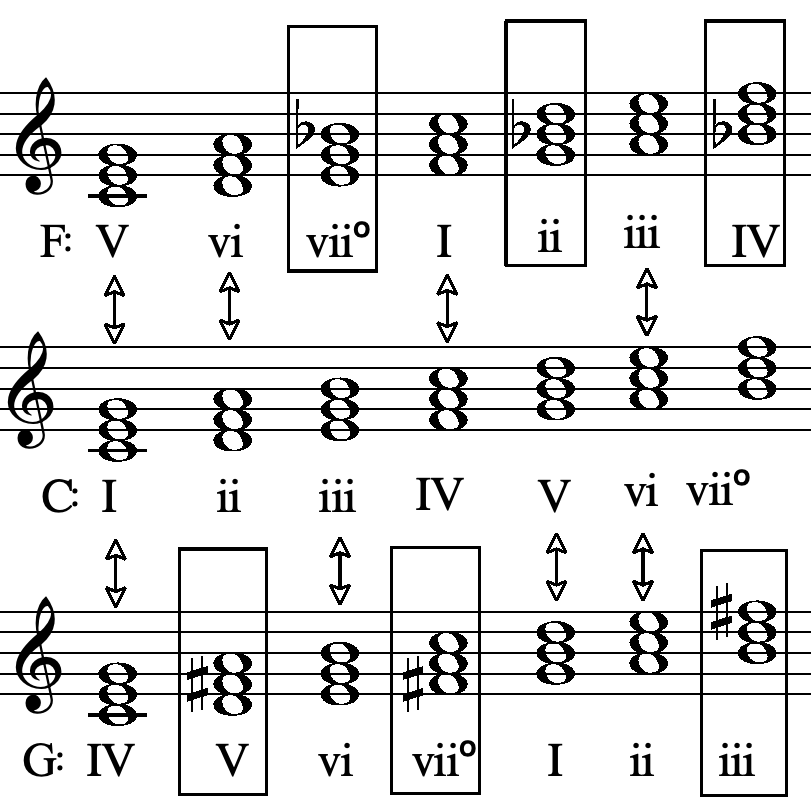

It's evident that many chords overlap among these keys. If our aim is to denote C major and we play chords common to G major, ambiguity arises between C and G major. Likewise, playing chords shared between C and F major introduces uncertainty about the key.
Establishing the Tonal Center
To differentiate and firmly set the key, one should play notes exclusive to the desired key, excluding the ones from adjacent keys on the Circle of Fifths. Investigation reveals that in the major mode, scale degrees [latex](\hat4)[/latex] and [latex](\hat7)[/latex] are pivotal for key determination. In minor mode, [latex](\hat4)[/latex] remains crucial, while the leadng-tone [latex](\hat7)[/latex] is derived from the Ascending form. The uniqueness of the minor mode is further reinforced by scale degrees [latex](\hat2)[/latex] and [latex](\hat6)[/latex]. Together, These degree pairs inherently demarcate the diatonic tritone, lending each mode its distinctive sound and attributes.
Cadences are essential here for helping us establish the tonal center and the key, as they not only conclude a harmonic sequence but also distinctly affirm the key by emphasizing the above-discussed defining scale degrees, thereby omitting neighboring keys from the tonal consideration.
Major Mode
In the major mode, the SubDominant and SuperTonic chords, sourced from the SubDominant region, encompass the defining scale degree [latex](\hat4)[/latex]. Meanwhile, chords from the Dominant region embed the leading-tone, scale degree [latex](\hat7)[/latex].
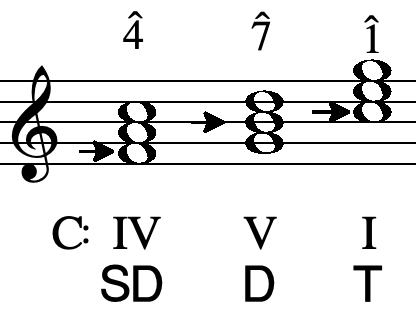

Both the Major-Minor (Dominant) Seventh chord and the Leading-Tone diminished triad encompass scale degrees [latex](\hat4)[/latex] and [latex](\hat7)[/latex]. These chords, by possessing both of the defining scale degrees, robustly fortify the tonal center in major mode.
Minor Mode
The mechanism in the minor mode parallels the major but offers more variety due to the dual nature of modern minor (i.e. the Ascending and Descending forms). Both the SubDominant and SuperTonic encompass key and mode-defining scale degrees [latex](\hat2)[/latex], [latex](\hat4)[/latex], and [latex](\hat6)[/latex]. It's noteworthy that either minor form, with a variable scale degree [latex](\hat6)[/latex]serve equally well in defining the key. In addition, when in the Ascending form, we get a leading-tone scale degree [latex](\hat7)[/latex], also providing a strong sense of definition.
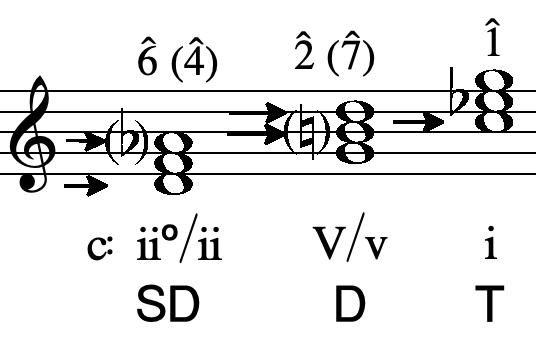
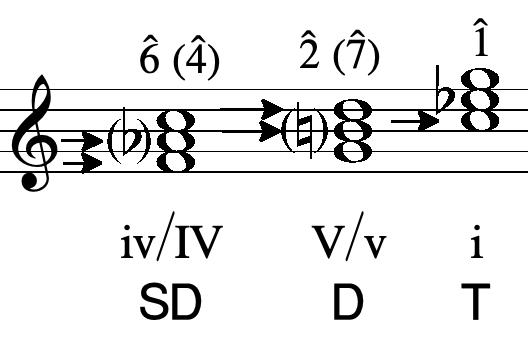
The fully diminished seventh chord, built on the raised scale degree [latex](\hat7)[/latex] from the Ascending (Harmonic) form of minor, and possessing the Natural sixth scale degree, is very potent, encapsulating all minor key and minor mode-defining scale degrees. This chord, akin to the diminished triad, can be thought of as an incomplete, rootless voicing of a ninth chord founded on the Dominant, essentially as a Dominant Seventh with an added flat ninth.
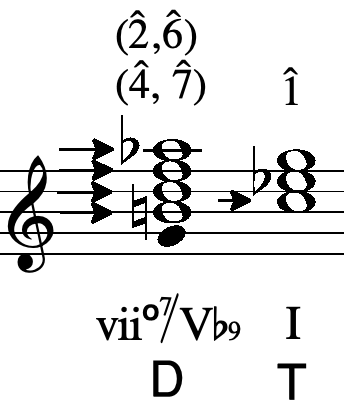
We will come back to the fully diminished seventh chord and explore its many additional possibilities in a later chapter.
Tritone and Scale Degree Melodic Tendencies
Earlier, we delved into the tendencies of the pivot tones in minor mode (tendency tones). Expanding on this concept, the diatonic tritones in both major and minor modes, demarcated by key and mode-defining degrees mentioned above, exhibit specific melodic voice-leading propensities. In both major and minor:
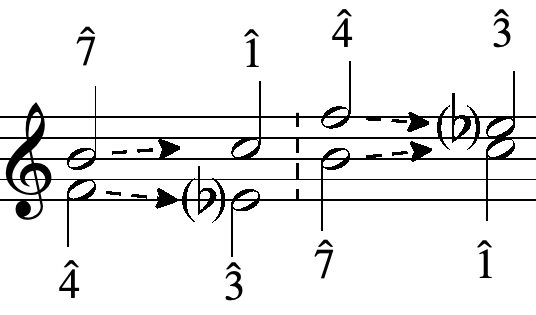
In Natural (Descending) minor:
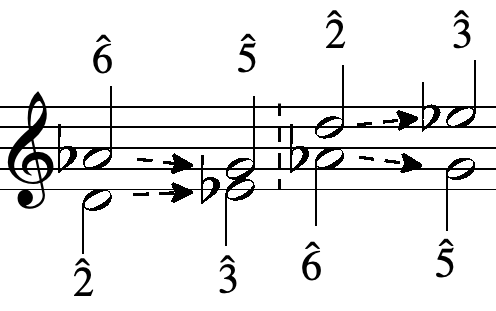
The Four Cadence Types
There are four primary types of cadences (closes) in tonal music: Authentic, Deceptive, Half, and Plagal.
Authentic
The Authentic cadence is the most definitive cadence, affirming the key and concluding on the Tonic triad. There are two types: Perfect (top voice melody terminates on the Tonic) or Imperfect (top voice melody concludes on another scale degree).
With regard to SATB voice leading, the most conclusive version of the Authentic cadence has the following:
- Each chord of the Cadence in Root Position
- The Dominant chord must be a complete chord with the root sounding (i.e. not a diminished triad or fully diminished seventh).
- Seventh chords, except for the Tonic triad, may be used, provided the voice-leading allows.
Deceptive
The Deceptive cadence seemingly sets up a closure but veers away from the Tonic chord, adding a twist to the listener's expectation. It is often a good way to both reaffirm a tonal center and key, but also provide further momentum in the musical phrase.
Half
The Half cadence offers a moment of pause, culminating on the Dominant chord rather than the Tonic, which then often moves on with a new musical phrase.
Plagal
Finally, we have the Plagal cadence, often termed the "Church" or "Amen" cadence. This cadence omits the Dominant, resulting in a less decisive closure. It is often used as an extension to an ending, after the sounding of an Authentic cadence, the purpose being to provide a more resolute conclusion. This cadence type appears regularly in popular song and contemporary pop, country and folk music.
As with the Authentic cadence, we have two forms of Plagal: Perfect and Imperfect, defined the same way as in the Authentic cadence by way of which scale degree is in the top melodic voice.
The Second Inversion (Six-Four) Triad in the Cadence
The Tonic second inversion triad, or the "Six-Four" chord, is pivotal in cadences. In the cadence. this chord is heard as a Dominant 6-4 dissonant suspension rather than a Tonic chord. How is this possible? The Dominant tone (scale degree [latex](\hat5)[/latex) is in the bass and, as we already know, any bass voice will exerts it's overtone series over the sounding notes above. Thus, the chord, by its very nature, is unstable, and it is quite easy and natural for the upper tones to have a strong pull toward neighboring tones that resolve in a root position chord (with the bass tone as the root), in essence, coming into "focus" and resonance with the harmonic series. This is one reason why we must be careful when using the second inversion triad, its inherent instability and its being at odds with the sounding tones.
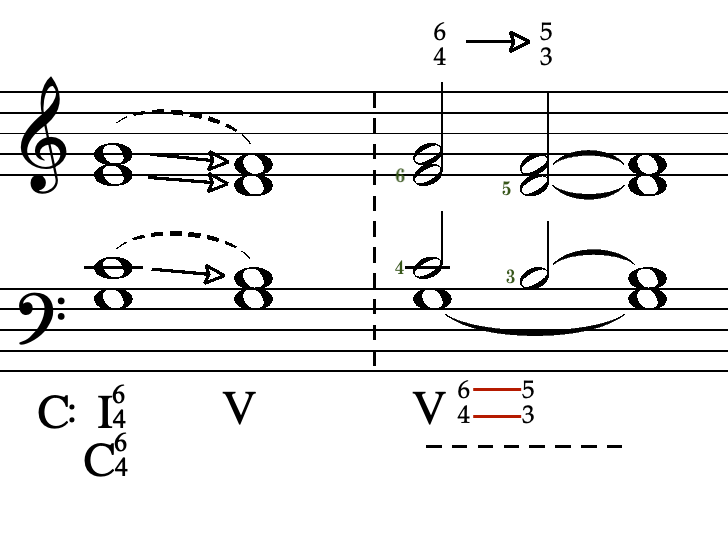
We may use this Cadential 6/4 chord in any Authentic cadence, sounding immediately after any pre-Dominant (SubDominant) chord, before the sounding of the Dominant chord. The effect is powerful and creates, as mentioned above, a sense of prolonging and tension, further elevating the final resolution to the Tonic. While it might be used as part of a Deceptive cadence, due to its power and affect, it is not well suited to such a situation unless very strongly warranted by the musical context.
Guidelines for Better Progressions
Root Progressions (in Major and Minor)
- Ascending root progressions, which move a fourth upward or a third downward, can occur anytime. However, avoid repetitive usage.
- Descending progressions, moving a fourth downward or a third upward, should be used when they contribute to an overall upward motion.
- Adjacent progressions sparingly unless specified otherwise. They aren't prohibited.
Chord Usage (in Major and Minor)
Triads
- Triads in root position are versatile and may be used anytime.
- Sixth chords enrich voice leading, especially in outer voices, and prepare dissonances. They may be used anytime (except at the start or end of a musical phrase).
- Use six-four chords cautiously. They're optimal in cadences (i.e. the Cadential 6/4) and with a moving bass-line in stepwise motion. Exercise care in all other situations.
- Diminished triads give a sense of necessity when introducing a chord, and further may be considered as a Dominant seventh chord.
Seventh Chords
- Seventh chords are as versatile as triads when prepared and resolved. They're best used where the seventh demands a specific resolution or treatment.
- Inversions of seventh chords improve voice leading.
The Minor Mode
- The careful handling of the pivot/tendency tones are essential. Incorporate the pivot tones during root progression harmonic progression outlines.
- Staying exclusively in one region (Ascending or Descending) can jeopardize the minor mode's character.
- Transitioning between regions should respect pivot tones (i.e. the four pivot tone guidelines).
- Triads may require inversions to prepare or resolve dissonances, especially with a pivot tone in bass.
- The same rules apply to seventh chords.
- After certain diminished triads, it's generally better to use the Ascending major Dominant chord (V).
- All diminished triads and their seventh chords have a distinct drive due to their dissonance.
- The augmented triad's versatility lets it transition between ascending and descending minor scales.
Voice Leading
- Avoid unmelodic intervals, especially without altered chords.
- Avoid repetitive tone progressions with the same harmony.
- Aim for a high and possibly a low point.
- Use steps and leaps for varied interval sequences, maintaining a mid-range.
- After a significant leap from the mid-range, try to return to it.
- If the mid-range is left stepwise, perhaps balance with an octave leap.
- If repetition is unavoidable, a direction change might help.
- These guidelines apply primarily to soprano and bass. If applied to middle voices, it elevates the overall smoothness. However, focusing on the outer voices is sufficient for now.
EXAMPLES: Triad Inversions and Seventh Chords in the Minor Mode
If the score above is not displaying properly you may CLICK HERE to open it in a new window.
RWU EXERCISES
Major and Minor: Chord Connection with Non-Common Chord Tones and Freer Treatment of Dissonance
Using the template below, please do the following:
- Compose at least four (4) harmonic progressions of your choice in SATB style, at least 7 to 12 chords in length:
- At least two (2) in the Major Mode (different keys of your choice) and two (2) in the Minor Mode (different keys of your choice)
- Consider the general guidelines above when constructing your phrases
- Each phrase should be planned out with root progression and harmonic regions in mind.
- Each phrase should have a good mixture of seventh chords and triads.
- Each phrase should contain one Deceptive cadence somewhere within the phrase and end with an Authentic cadence (perfect or imperfect)
- Two of your phrases should end with an Authentic cadence which uses the Cadential Six-Four chord
- Label your cadences with the following text: DC (Deceptive Cadence), IAC (Imperfect Authentic Cadence), PAC (Perfect Authentic Cadence).
- At least two (2) in the Major Mode (different keys of your choice) and two (2) in the Minor Mode (different keys of your choice)
(you must be logged into your Noteflight account to open the activity templates above)
Schoenberg Theory of Harmony Examples
Further Reading
- Schoenberg, Arnold: Theory of Harmony
- Schoenberg, Arnold: Structural Functions of Harmony





